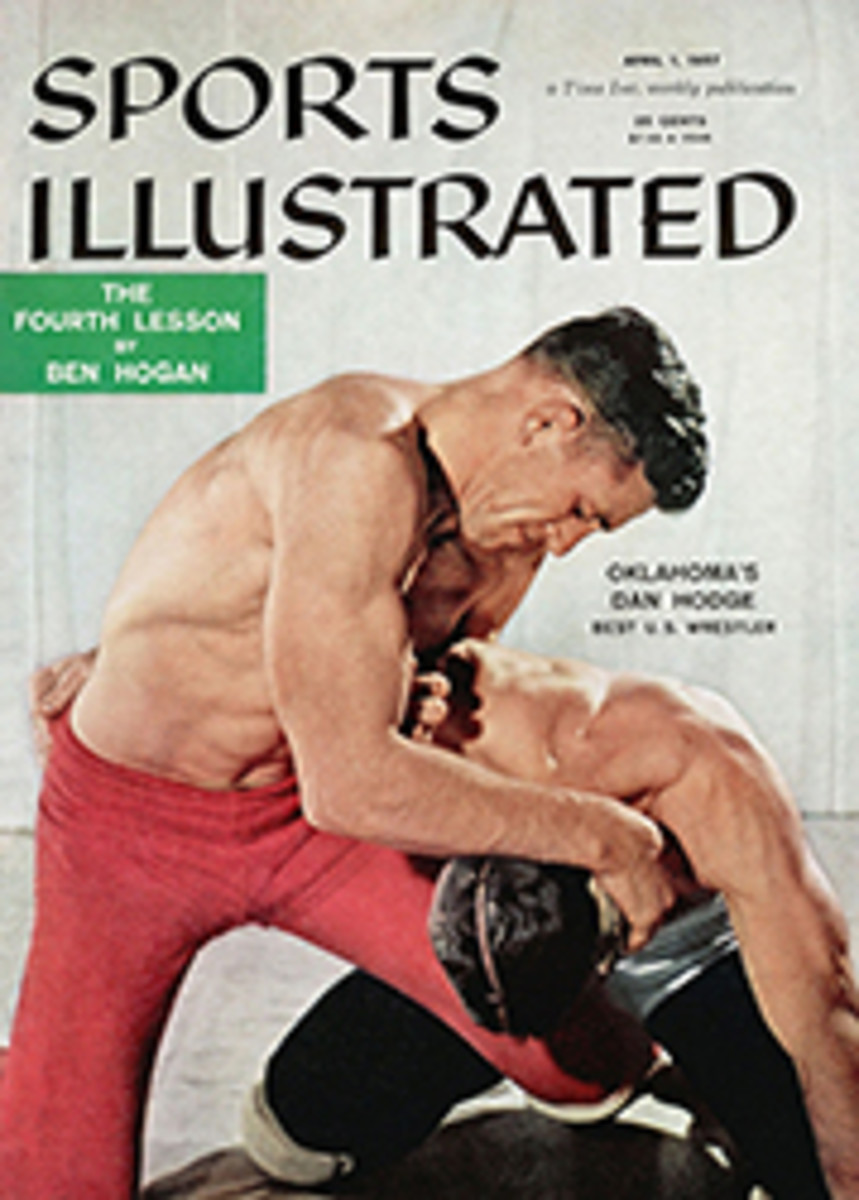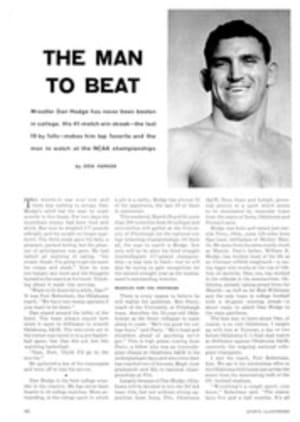
KING OF THE HILL
Contemplating the forbidding figure of Coach Willy Schaeffler (right), Dave Shaw, co-captain of Denver University's crack ski team, said recently, "Sometimes he antagonizes you to the point where you want to challenge him, but you go out and win instead." That, in a sentence, is the story of Willy Schaeffler, the most successful ski coach in the United States. It is also the story of the Denver team, which was a collection of unknowns until Willy arrived from Bavaria in 1948. Since then they have won five national collegiate ski championships, the last three in a row. And this coming weekend, March 29-31 at Snow Basin in Ogden, Utah, they will be odds-on to make it four in a row.
What Willy has done is take a collection of good skiers and, by driving them to the point of exhaustion six months out of the year, has conditioned them and molded them into one of the toughest teams in the history of college skiing. "I try to make practice so hard," says Willy, "that competition is easy."
The grind begins for Denver skiers the day they arrive for school in the fall. Willy starts them off by running them up and down the football stadium steps (80 rows), first frontwards, then backwards. If they make it all right, Willy sets them hopping on one foot—all the way up and back.
On that same first day they go through wind sprints, digging across the turf with summer-softened legs. By late afternoon the Denver ski team is likely to look like a bunch of Roger Bannisters coming over the finish line after a new mile record. At that point, Willy blows the whistle and starts a soccer game. "They like the game so much," chuckles Willy, "that they run another three or four miles playing it." After soccer, even Schaeffler is willing to call it a day. But it behooves a Denver ski candidate to live close to the football field, because Willy has one word to say about automobiles: "Verboten." His skiers walk everywhere they go.
For some of the recruits, one day under Willy is enough. "It's very hard," he conceded in a moment of compassion. "A few of the boys quit, sometimes real good skiers. But," he added, hardening up, "if they haven't got the will power for it they won't stand up in competition."
When the brave survivors turn out the second day, the third day and on into the early weeks of training, they find the need for will power more acute. From the wind sprints they now progress to running six miles a day across fields, down highways, along sections of railroad ties, teetering back and forth to sharpen their balance. They run down jagged hills, over jumps, across rocks and ditches, and at top speed through thick woods. And when they get back to the football field, there are the wind sprints and the hopping races up the stadium steps again, only this time each runner and climber is carrying a teammate—or Willy—in his arms.
Faced with this Spartan routine, the Denver kids would probably all throw in the towel before the first snowfall except for one decisive fact. Everything the boys do, Willy does. And at 41 he can still do everything better, stronger and longer than any of his 20-year-old champions. When six skiers rumble down the field, each lugging a hefty teammate, the man in front is always Willy. When they scramble through the six-mile torture of a crosscountry run, there is Willy out in front. "I hear the boys talking among themselves," he said, smiling. "They say if he can do it, an old man, we got to do it." And when the soccer game starts, there is Willy, giving it all he's got. Sometimes he gives too much, like the midwinter day three years ago when he staggered out of a ball scramble with a broken leg. But even that didn't stop him. A cast on the leg, a short ski strapped onto the cast, a couple of crutches tucked under his arm, and he was out on the slope shuffling around, conducting practice.
It hardly hurt at all. Besides, broken bones are nothing new to Willy. In 1936, four years after he won the Bavarian junior Alpine championships against some of the best young skiers in the world, Willy came whooshing off the end of a ski jump squarely into a loose toboggan. Fracture count: 14, including two broken legs. As a German soldier, he got it even worse. In 1940 he was thrown into a penal battalion (for anti-Nazi Germans) that later spearheaded the drive on Moscow, was wounded three times, the third time so badly he was thought beyond recovery.
Skiing in Garmisch after the war, which he finished in an Austrian underground unit, he was hurt again when he schussed into a stump, flew through the air and landed on another stump. Score this time: six ribs and a left hip.
Since he emigrated to America in 1948, Willy has managed to keep his fracture count down to two: the soccer accident and a broken thighbone in the 1950 FIS trials. He has also managed to keep the accident rate astonishingly low among his Denver boys. He does it by making them so hard and tough that their legs can take anything. And he does it by making sure that each boy knows exactly what he's doing before he ever goes to the starter's gate. The first snow in Denver usually arrives the first week in November. Instead of breaking out the slalom poles, Willy starts the team off on the lowly snowplow. "There are many skiers today," Willy explained, "who came along so fast with a reputation as skiers that they never really took time to perfect the basic maneuvers. Fast competition is dangerous for boys like this. All they know is how to ski fast, or else they have learned to look fancy, or copied the form of stars they have seen. You must have" the fundamentals, and I try to teach the boys to build up their fundamentals so that speed no longer is a danger."
When he is at last convinced they know what they're doing, Willy leads them to the mountain for some skiing. He sends the slalom specialists blazing through clusters of gates faster and faster until they lose control and skid out over the poles. "I want them to be able to see what it's like to do a hairpin turn at great speed," he said. "I want them to build up judgment about speed. They may knock the next pole out, or not make the turn, but it helps them learn about their own speed. You test the impossible until you find the possible."
With the downhill men he stresses the ability to read the course, to make decisions while rattling over sudden drop-offs at 60 miles per hour when the wrong move can mean the race—or broken bones. "Downhill," he explained, "requires a cool head more than anything else."
The cross-country men get their lectures, too, mainly on conditioning, but also on going all-out to the very end of the race, even if it is only to hang onto third or fourth place. For college skiing is a team effort, scored on total points, and a moment's rest by a runner-up anywhere along the course in a nine-mile race could lose the entire meet.
To the jumpers, he has this to say: "The real art of jumping is to come as close as you can to the take-off point before you make your jump." Four of the boys on his team are Norwegians, two of them skilled in the floating technique that gets best results on the big hills of Europe. Here, it's different. "On the smaller jumps in intercollegiate competition, which aren't very fast, the quick spring at the right take-off point means everything."
If the lectures don't work, Willy straps on the skis and shows how it's done, slamming through slalom gates and pumping over the rugged crosscountry runs.
The boys themselves stand in awe of these demonstrations, in fact, of Willy's entire person; and even though he sometimes prods them to the brink of homicide, there is no doubt that they love their Willy. "It's his own tremendous personality and drive that makes us go," says Star Jumper Al Vincelette, who two weeks ago won the North American Nordic title. "He does everything with us, and it makes the boys want to work as hard as they can. When he comes across something new he finds out all he possibly can about it, reads everything and then talks about it. He figures out everything on paper—which boys will make us stronger in which events. He has every guy on the squad figured to a tee, and he figures out exactly where he can get the most points. We respect him tremendously, everybody does. We all feel close to him. Often he makes us mad, but no one is afraid to speak up to him. Always with respect, though. He's a friend, but he always keeps that line of authority drawn."
When Willy's boys go into the NCAA championships this weekend, they'll need every ounce of courage and conditioning that he has given them. The Dartmouth team, which Willy shoved from the pinnacle of college skiing six years ago, is loaded with top skiers. Its Alpine squad, headed by Olympic Stars Chiharu Igaya (SI, Jan. 9, '56) and Ralph Miller, is, according to Willy, "the best college Alpine team I have ever seen." Colorado University and Western State, who handed Denver its first defeat in 21 meets last December when two of Willy's downhill men fell and failed to finish, are gunning for Willy's boys. So is every other top ski college in the country. But Willy will be ready for them. Testing the snow, waxing every pair of skis his boys use in the meet, shrieking advice to jumpers, galumphing through the snow feeding oranges and dextrose to his cross-country men, figuring points down to the last fraction, he'll be trying to keep Denver on top—where he figures it belongs. "If things go our way," he said last week, "I think we can beat anybody in the country, Dartmouth included."
PHOTO
TOUGH TASKMASTER Schaeffler bosses D.U. skiers like Marine drill instructor.
THREE PHOTOS
WILLY BEGAN AS SHEPHERD BOY IN BAVARIA, FOUGHT IN WEHRMACHT OUTSIDE MOSCOW IN 1941, JOINED THE AUSTRIAN UNDERGROUND IN 1944
PHOTO
ON THE HILL with his Denver skiers, tireless Schaeffler explains slalom problem.

